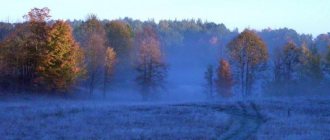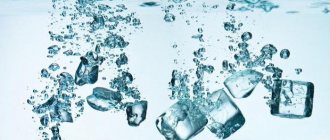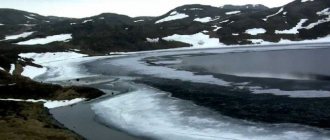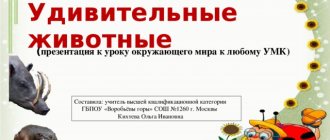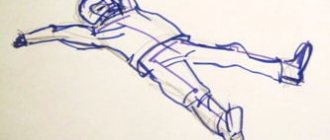Hello everyone, the leaves have long fallen from the trees, there is crisp ice on the puddles, you can’t hear the chirping of birds - these are the main signs of winter in wildlife that say that winter is coming.
Do you want to know what happens in nature on the threshold of winter? How do trees, birds, animals, insects, and fish prepare for winter? Surprise your friends with your knowledge about wildlife? How often does someone ask: “When will winter come?” Tired of this autumn slush...
Quote from Pushkin: - That year, the autumn weather stood for a long time in the yard, Nature was waiting, waiting for winter..., answer - In fact, the signs of winter are already everywhere in nature.
You can only be able to determine the onset of winter in nature by observing changes in nature, where everything is interconnected - winter and summer, spring and autumn.
Signs of winter in inanimate nature
The first signs of winter can be detected by all living things.
It is still far from cold weather and there is no snow and frost, but it is already clear that winter is on the doorstep.
- The days are getting shorter, the nights are longer and colder, the slanting rays of the sun cannot warm the earth during the day.
- The clouds hang low, become heavy, sad gray, and fill the entire sky.
- The air is damp and cold.
- An ice crust appears on the puddles.
Presentation for a lesson on the world around us (grade 2) on the topic: Presentation On a visit to winter - presentation
Kobelkova Olga Nikolaevna primary school teacher MKOU Nechaevskaya secondary school The world around us, 2nd grade. "Inanimate nature in winter"
It's getting cold. The water turned into ice. The long-eared gray bunny turned into a white bunny. The bear stopped roaring: The bear fell into hibernation in the forest. Who can say, who knows, When this happens?
Winter... The sun now rises very low in the sky, the days are short. The earth receives little heat. Snow covered the ground and tree branches. Rivers, lakes, and ponds are covered in ice. The soil is frozen.
In winter the weather is usually frosty. The snow at this time is dry and powdery.
But thaws often occur. Then the snow melts, becomes wet and sticks together.
It is very interesting to watch the snowfall. On windless days, snow falls to the ground calmly, slowly. Snowfall accompanied by strong winds is called a blizzard. The snow is spinning, rushing through the air and on the ground.
Quite often in winter, a fluffy snow fringe forms on trees and wires. This is frost. It is especially beautiful at this time in the forest.
December December the year ends and winter begins. In December the frost increases, but the day arrives. The frost is not great, but it is not good to stand.
January The month of January is winter, sir. January – clematis: take care of your nose. In January, the cold hung over the earth.
In February, two friends - frost and blizzard. Storms and blizzards arrived in February. February draws, paints, smells the red spring. February
Snow The tablecloth is white The whole world is dressed. It lies quietly all winter, and in the spring it will run away.
Frost Pattern on glass A strange glazier came to us: He grabs everyone by the nose, Every day he inserts stronger and thicker glass. Did the job quickly and quickly, Clean work - Glazed ponds, lakes, Puddles, swamps.
Snowflakes What kind of through stars are there on the coat and on the scarf, All through, cut out, And if you take it - Water in your hand.
Frost is not snow, not ice, but will remove the trees with silver.
Icicle White carrot grows in winter. It grew, it grew, it came out of its beard, it became the sun, nothing became.
Ice is not a precious stone, but glows. Doesn't burn in fire, doesn't drown in water.
Blizzard, blizzard. Walking in the field, but not a horse, flying in the wild, but not a bird. I mumble, I mumble, I don’t want to know anyone.
Rules for safe behavior in winter. 1. Do not touch metal surfaces with bare hands in the cold. 2. When your face begins to freeze from frost and cold, you can rub it with the dry surface of your hands. Do not rub your face with snow or the fabric of gloves/mittens; they can damage the skin and cause infection in the resulting wounds. 3. When returning from frost to a warm room, you should not immediately expose the surface of frozen parts of the body to a direct heat source (radiators, hot water, radiators, heaters, etc.). In such cases, rapid heating of the frozen surface of the skin can result in serious damage and even burns. You need to warm up from the frost gradually. It is best to lie down under a blanket and drink hot tea.
html - rules of conduct
How plants greet winter
The main signs of approaching winter are shown by trees and shrubs. In anticipation of a cold winter , trees not only shed their leaves; under their bark, cork tissue has become denser during the winter and has been added over the summer, which keeps heat inside the trunk, like a double-glazed window.
They shed their leaves, taking care of themselves: under the cover of last year's foliage, the roots will freeze less. Trees and shrubs “fall asleep” in winter so as not to waste energy and nutrients on vital activity.
What signs of approaching winter are visible in herbaceous plants?
- — Annual plants die, dropping their seeds into the ground. Next spring, in warm soil, the seeds that have lain under the snow all winter will again give life to the plant.
- — Perennial plants store nutrients in their rhizomes all summer. Their bright summer greenery turns yellow and fades. Some herbs retain color, even fruits (lingonberries and cranberries).
Winter changes in wildlife
Hello guys! I am the forest fairy Snezhana.
Remember? In the last lesson we talked to you about winter changes in inanimate nature. Today I invite you to take a journey into the world of wildlife.
Let's take a walk through the winter forest and see how plants overwinter.
Deciduous trees and shrubs
They have long shed their leaves and are standing
naked
. But their trunks and branches, thanks to their thick bark, are not afraid of winter cold. And the buds are reliably protected from frost by dense leathery scales.
Spruce and pine
They shed their needles gradually, so they remain
green
. The needles of these trees are covered with dense skin, which protects them from winter cold.
The forest covered with snow is fraught with many wonders. If you rake the snow in the right place, you can find small plants with green leaves and red juicy berries. These are lingonberries and cranberries
.
Lingonberries and cranberries
- evergreens. In autumn they do not shed their leaves and remain green under the snow. And the berries match the leaves - they are not affected by frost, nor are they afraid of snow. Just as red as in autumn, and just as tasty.
The underground parts of perennial herbaceous plants overwinter in the soil. Snow cover protects seeds ripened in summer and autumn. Next year, new plants will grow from them.
Winter is a difficult time for animals. Some animals have nothing to feed, others are cold, others are both cold and hungry.
. And most animals somehow escape winter, settling down to survive this difficult time.
Easier
The only places to hide for the winter
are insects, spiders
, and other terrestrial small fry.
A crack in the bark, fallen leaves, any crack in the ground - everything is suitable for the winter quarters of a fly, caterpillar, or spider
. Hiding, they fall into a stupor. They will remain in this state until spring, until the warm spring sun warms them.
And here are the bees
do not fall into torpor during the winter. Having gathered into a large lump, they warm each other. Honey reserves are used for nutrition.
Fish
They spend the winter differently.
Carp, bream
hibernate in holes at the bottom of reservoirs over the winter.
The catfish and carp
, sworn enemies, sleep at the bottom of the reservoir nearby During hibernation, summer hostility is forgotten. Catfish lie at the bottom of the river, and on them are carp. Numb, covered with a thick layer of mucus, predators do not hunt, although prey is nearby: just open your mouth.
And perch and pike
do not hibernate. Experienced fishermen know this and get a good catch during winter fishing.
Many birds
All daylight hours are spent searching for food
.
Bullfinches, tap dancers and waxwings
looking for seeds and fruits of plants. Pay attention to this beautiful bird.
This is a waxwing
. The waxwing has a short tail with a bright yellow stripe, bright red feathers on the tips of its wings and a large crest on its head. This bird is very gluttonous, and it also sometimes faints. Very unusual, isn't it? The thing is that the waxwing has very fast digestion, so the birds are forced to eat a lot often. Once on the mountain ash, they will not miss the opportunity to refresh themselves once again. And the fruits are frozen. A bird's crop filled with them cools the entire body and compresses the airways. This is what happens when a waxwing that has overfed itself becomes semi-fainting. And he falls from the tree to the ground. Only after some of the berries have thawed and passed into the stomach, the bird comes to its senses and begins to eat again.
Tits
, permanent residents of our area, examine cracks in the bark of trees in search of food. They penetrate cracks with their strong, laterally flattened beak and extract insects, their larvae and pupae. Most of these insects are pests of forests, gardens, and parks. This activity of tits is especially useful because they destroy pests not only in summer, but also in winter, when most insectivorous birds have flown to warmer climes. With their beak, tits also easily pull out seeds from under the scales of coniferous trees and peck at various fruits. Tits are very voracious; they eat as much food per day as they weigh. All tits are friends of man and deserve the most caring attitude towards themselves, especially in difficult times for them. Each of you can help the birds by hanging feeders and regularly filling them with grain, bread crumbs and seeds.
Flocks of tits roam in the forest all winter together with kinglets and nuthatches.
.
Kinglet
- a little one, like a dragonfly. Weighs 5-6 grams. He silently flutters along the branches, as if from floor to floor. It tugs at the hanging moss and picks scales off the branches. It destroys a million pests a year.
Nuthatch
more king. It is 12–14 cm long. It has a short, almost invisible neck. And its legs are strong, with long, tenacious claws, which allows it to easily climb tree trunks. The ability of nuthatches to run up and down tree trunks is well known. The common nuthatch is a noisy bird, with a large repertoire of different loud sounds.
Animals
Also, those who can adapt to winter as best they can.
During wintering, mice They often come to the surface and leave their footprints in the snow. This exit is fraught with many dangers. You can even fall into the clutches of a mousey fox.
Squirrel
In winter, neither frost, nor wind, nor snow are scary. As soon as a blizzard or bad weather begins to swirl, the squirrel quickly hurries to its nest. Squirrels make nests only in trees. In deciduous forests it usually lives in hollows, dragging there a soft bedding of grass and dry leaves. In conifers, it builds spherical nests from dry branches, which are lined from the inside with moss, leaves, grass, and wool. The squirrel will climb into the nest, and to prevent the cold wind from blowing in, it will also close the loophole with bedding. Then he curls up into a ball, covers himself with his fluffy tail and sleeps. And the squirrel has food stored up since the fall - enough for the whole winter.
Predatory
animals
hunt in winter.
Wolves
attack
moose and wild boars
. They usually unite in flocks; together it is easier to get food.
Some animals spend the winter hibernating
.
The bear
sleeps in his den, lined with soft fragrant pine needles and dry moss. And the stronger the frost, the more soundly and deeply the bear sleeps. And in late winter, female bears give birth to tiny, blind cubs. Warmth for the cubs in a snow-covered den.
Jerzy
They also spend the winter in deep hibernation. They sleep in heaps of dry leaves, grass and moss. At this time, they do not eat anything, but live off the subcutaneous fat accumulated since the fall. Their breathing slows down greatly and their body temperature drops.
Badgers
They also sleep, having brought sphagnum moss, which heals wounds, and chamomile, which kills harmful insects, into the nesting chamber just before hibernation. And for the bed itself, the badger usually chooses clover - crushed, it does not rustle like other herbs. True, the badger does not sleep very soundly - sometimes it wakes up, especially during thaws. Then he gets out to bask in the sun. And then he goes back to bed. Until spring.
This is how plants and animals live in winter.
And now, it's time for us to say goodbye. Goodbye.
How birds prepare for cold weather
It’s not easy for birds in the cold, there’s not enough food. To withstand and survive the frost, a bird needs to eat as much food as it weighs.
Bird conversations in the forests fall silent, quiet and lifeless without their hubbub. The birds scattered to the south in search of food-rich lands. Many wintering birds move closer to people's homes (tits and bullfinches).
Frost-resistant species of birds “goosebumped” and prepared food.
Birds spend the night and look for food in cold weather in flocks and flocks; in winter a bird cannot be alone: together and from predators it is easier to protect yourself and look for food.
Animal behavior
A frosty winter brings with it more than just snow and cold. During this period, food becomes so scarce that animals are forced to adapt to such difficult conditions in order to survive.
There are much fewer birds, because many of them go to warmer climes to wait out the frosts in more comfortable conditions. Those who remain have to spend all their time searching for food, because in winter the bird needs as much food every day as it weighs - this is the only way to survive the extreme cold. Therefore, many birds move closer to human habitations.
Rice. 2. Bird feeders.
Animals have a hard time too. Some of them hibernate - this makes it easier for the animal’s body to wait out unfavorable times: breathing and heart rhythm weaken, body temperature drops, and digestion stops. Bears, chipmunks, raccoons, hedgehogs, badgers, hamsters, lizards, frogs, and snakes resort to similar tricks. Those animals that remain active in winter change their outfit to a warmer one.
Rice. 3. White hare.
Well, how do insects winter? They begin preparing for winter in the summer, collecting food supplies in their “houses.” With the onset of the first cold weather, ants hide in their anthills, tightly closing all passages, bees and wasps seal all the cracks in their nests with wax, beetles and flies hide in cracks, under the bark of trees.
What do animals do on the eve of frost?
The most characteristic signs occur in the world of animals awaiting the onset of frost. Knowing that winter is coming, many animals hibernate - this is an adaptive mechanism of some species of animals and plants during winter and frost. A way not to die of hunger.
During hibernation or torpor, the body temperature of animals decreases, digestion stops, heart rhythms are rare, and breathing is weak. Bears make warm and cozy dens for themselves. Other animals also hibernate: badgers and hedgehogs, raccoons and chipmunks, hamsters and dormice, bats and snakes, frogs and lizards.
Who changes the color, insulates the fur coat? Which animal does not look forward to warm weather in winter?
- The hare changes the color of its skin from gray to a white, warm new thing.
- Squirrels put on winter outfits: their summer red sundresses are easy to see on gray tree trunks, because they turn gray, in this way they camouflage themselves from predators.
- And predators camouflage themselves; protective coloring will allow them to hunt more successfully. Arctic foxes change from dark gray to snow-white. The stoats and weasels turn white.
The fur coats of animals become richer not only in terms of coloring, but as winter approaches, a thick, short undercoat grows closer to the skin, which provides warmth in the winter frosts.
How do insects survive in winter?
Insects are also waiting for the onset of winter and have been preparing for it since summer.
Ants hid deep underground, closed the entrances to the house, and they are not visible. Ants huddle in groups and economically eat summer food supplies while waiting out the winter.
Wasps and bees seal the honeycombs, form swarms, and cover all the cracks of the nests with wax. They feed on honey reserves.
Flies, butterflies and beetles just sense the signs of winter - they hide under the bark of trees, hide in cracks, wait out frosts in a state similar to the hibernation of animals, this state is also called suspended animation.
How fish and underwater inhabitants live under the ice
The water temperature in rivers and reservoirs drops every day, ice freezes - it is clear to underwater inhabitants: winter is coming according to the time of year. Under the layer of ice it becomes dark and there is not enough oxygen. All inhabitants have developed reflexes that help them survive the winter.
Crayfish dig holes in river banks and lead an inactive lifestyle, and female crayfish also bear eggs at this time.
All aquatic life awaits the onset of winter. Fish accumulate fat all summer, and spend it sparingly in winter.
- — There are types of fish (carp and tench, catfish and crucian carp) that go to wintering pits at this time, where they bask side by side, being half asleep.
- — Active predators (pike, perch and pike perch) do not change their lifestyle even in winter.
